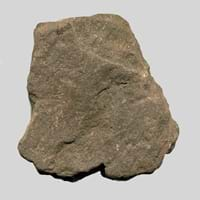Shale and Charnockite
Definition
Definition
Shale is a fine-grained sedimentary rock which is formed by the compaction of silt and clay-size mineral particles
Charnockite is a variety of granite containing minerals like orthopyroxene, quartz, and feldspar
History
Origin
Unknown
Tamil Nadu, India
Discoverer
Unknown
T. H. Holland
Etymology
From German Schalstein laminated limestone, and Schalgebirge layer of stone in stratified rock. From Old English scealu in its base sense of- thing that divides or separate,
From Job Charnock, an administtrator of East India Company
Class
Sedimentary Rocks
Igneous Rocks
Sub-Class
Durable Rock, Medium Hardness Rock
Durable Rock, Hard Rock
Family
Group
Not Applicable
Plutonic
Other Categories
Fine Grained Rock, Opaque Rock
Coarse Grained Rock, Opaque Rock
Texture
Texture
Clastic, Splintery
Granular
Color
Black, Brown, Buff, Green, Grey, Red, Yellow
Black, Grey, Orange, Pink, White
Maintenance
More
Less
Durability
Durable
Durable
Water Resistant
No
No
Scratch Resistant
No
Yes
Stain Resistant
No
Yes
Wind Resistant
No
No
Acid Resistant
No
Yes
Appearance
Muddy
Veined or Pebbled
Uses
Architecture
Interior Uses
Decorative Aggregates, Homes, Interior Decoration
Bathrooms, Countertops, Decorative Aggregates, Entryways, Floor Tiles, Homes, Hotels, Kitchens, Stair Treads
Exterior Uses
As Building Stone, As Facing Stone, Office Buildings
As Building Stone, As Facing Stone, Bridges, Paving Stone, Garden Decoration, Office Buildings, Resorts
Other Architectural Uses
Curbing
Curbing
Industry
Construction Industry
Cement Manufacture, Construction Aggregate, for Road Aggregate, Making natural cement, Raw material for the manufacture of mortar
As Dimension Stone
Medical Industry
Not Yet Used
Not Yet Used
Antiquity Uses
Artifacts, Sculpture
Artifacts, Monuments, Sculpture, Small Figurines
Other Uses
Commercial Uses
Creating Artwork, Pottery
Curling, Gemstone, Laboratory bench tops, Tombstones
Types
Types
Red Shale, Black Shale, Green Shale, Grey Shale and Yellow Shale
Enderbite
Features
Easily splits into thin plates, Generally rough to touch, Very fine grained rock
Available in Lots of Colors and Patterns, It is One of the Oldest, Strongest and Hardest Rock
Archaeological Significance
Monuments
Used
Used
Famous Monuments
Jantar Mantar in India
Data Not Available
Sculpture
Used
Used
Famous Sculptures
Data Not Available
Data Not Available
Pictographs
Used
Not Used
Petroglyphs
Used
Not Used
Figurines
Used
Used
Fossils
Present
Absent
Formation
Formation
Shale forms when very fine-grained clay particles are deposited in water which settle at the bottom of water bodies. They are later compacted hence forming shale.
Charnockite is an intrusive igneous rock which is very hard and is formed due to weathering of existing rocks.
Composition
Mineral Content
Albite, Biotite, Calcite, Chert, Chlorite, Dolomite, Hematite, Micas, Muscovite or Illite, Pyrite, Quartz, Silica, Sulfides
Amphibole, Biotite, Feldspar, Hornblade, Micas, Muscovite or Illite, Olivine, Plagioclase, Pyroxene, Quartz
Compound Content
Ca, Fe, Mg, Silicon Dioxide, Sodium
Aluminium Oxide, CaO, Iron(III) Oxide, FeO, Potassium Oxide, MgO, MnO, Sodium Oxide, Phosphorus Pentoxide, Silicon Dioxide, Titanium Dioxide
Transformation
Metamorphism
No
Yes
Types of Metamorphism
Not Applicable
Burial Metamorphism, Contact Metamorphism, Regional Metamorphism
Weathering
Yes
Yes
Types of Weathering
Biological Weathering, Chemical Weathering, Mechanical Weathering
Biological Weathering
Erosion
Yes
Yes
Types of Erosion
Chemical Erosion, Coastal Erosion, Glacier Erosion
Chemical Erosion, Water Erosion, Wind Erosion
Properties
Physical Properties
Hardness
3
6-7
Grain Size
Very fine-grained
Coarse Grained
Fracture
Not Available
Not Available
Streak
White
White
Porosity
Highly Porous
Very Less Porous
Luster
Dull
Not Available
Compressive Strength
95.00 N/mm2
20
Not Available
Cleavage
Slaty
Not Available
Toughness
2.6
Not Available
Specific Gravity
2.2-2.8
Not Available
Transparency
Opaque
Opaque
Density
2.4-2.8 g/cm3
2.6 g/cm3
Thermal Properties
Specific Heat Capacity
0.39 kJ/Kg K
23
Not Available
Resistance
Heat Resistant, Impact Resistant
Heat Resistant, Wear Resistant
Reserves
Deposits in Eastern Continents
Asia
Bangladesh, China, India, Russia
India
Africa
Ethiopia, Kenya, Morocco, South Africa, Tanzania
East Africa, Ethiopia, Madagascar, Morocco, Mozambique
Europe
Austria, France, Germany, Greece, Italy, Romania, Scotland, Spain, Switzerland
Albania, Romania, Scotland, United Kingdom
Others
Not Yet Found
Not Yet Found
Deposits in Western Continents
North America
USA
USA
South America
Bolivia, Chile, Colombia, Ecuador, Peru, Venezuela
Brazil, Colombia, Venezuela
Deposits in Oceania Continent
Australia
New South Wales, New Zealand, Queensland, Victoria, Western Australia
Central Australia, Western Australia
All about Shale and Charnockite Properties
Know all about Shale and Charnockite properties here. All properties of rocks are important as they define the type of rock and its application. Shale belongs to Sedimentary Rocks while Charnockite belongs to Igneous Rocks.Texture of Shale is Clastic, Splintery whereas that of Charnockite is Granular. Shale appears Muddy and Charnockite appears Veined or Pebbled. The luster of Shale is dull while that of Charnockite is not available. Shale is available in black, brown, buff, green, grey, red, yellow colors whereas Charnockite is available in black, grey, orange, pink, white colors. The commercial uses of Shale are creating artwork, pottery and that of Charnockite are curling, gemstone, laboratory bench tops, tombstones.
|
||
|
||
|










